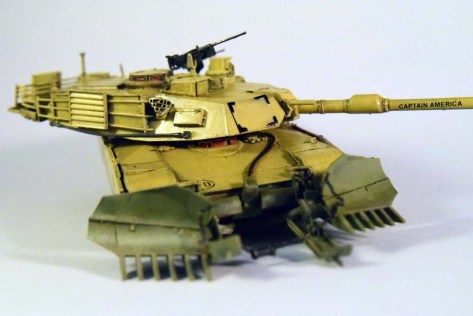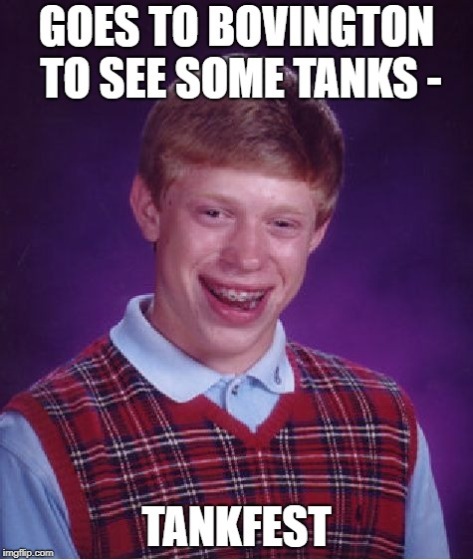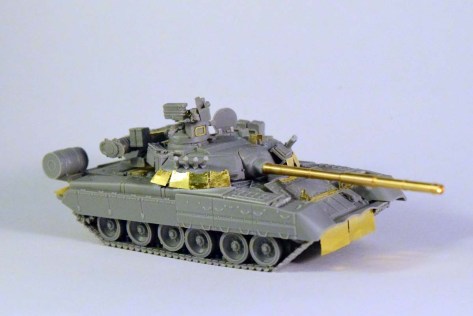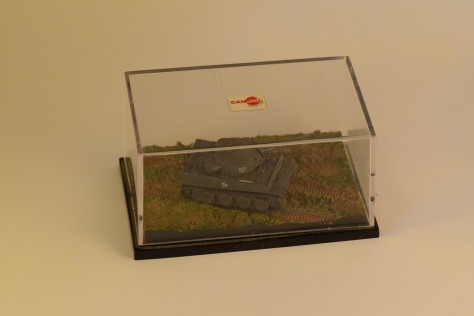
The M1A2 SEP (System Enhancement Package) is an updated version of the Abrams featuring depleted uranium reinforced armor, updated ballistic computers, fire control and other systems. This is an upgrade package that can be applied to any M1 variants: several older M1A1 were updated to the M1A2 SEP levels. (A good summary of the vehicle can be found here.
I was quite interested in Flyhawk’s M1A2 SEP model; all their kits I’ve built so far looked like miniaturised 1/35th scale models with regards to detail (and sometimes complexity), so there’s quite a reputation to uphold.
(In short: they do.)
The packing of the model is exceptional: all the sprues placed in the same bag are fixed together with a thin rubber band; and the delicate parts for the turret baskets are wrapped in packing foam to prevent damage.
The PE fret has a circular mask for the wheels; it is a really welcome feature.
The plastic is exceptional quality, all the ejection pin marks are in inconspicuous places, and the sprue gates are very small. There is virtually no flash to clean up. The detail is simply speaking incredible – the best example is the subtle but very realistic anti-slip surface on the turret and hull, or the single-piece gun barrel. The machine guns are pretty amazing, too: the barrels are hollowed out, and the ammunition belt running from the ammunition box is modelled, too. (Something 1/35 scale kits sometimes do not have.)
The instructions are provided in a booklet for the tank, and as a fold-out page for the mine plough. Interestingly the assembly of the mine plough has as many steps as the tank itself (although it’s obviously less complex.) The booklet is very well designed; the English is not very good, but understandable. (Being someone whose English is not perfect either, I should not be throwing stones, though.) The instructions make very good use of colors to help with the assembly process, and also provide several views of the more difficult steps to aid the modeller. Flyhawk also provided tips and some useful pieces of advice, which is very much welcome. The instructions, and the fact that the whole model was designed to be as user friendly as possible, makes for a very pleasant building experience. (The design is excellent: it is very difficult to mistakenly attach something upside down or on the wrong side – even the gun barrel is moulded in a way that it only fits into the mantlet in one way.)
As far as I could determine the model is accurate. The size is spot-on for 1/72, but I’m not really familiar with the M1- people who are better acquainted with the type are more qualified to judge the accuracy of the model.
The lower hull is assembled from four parts: a bottom, two sides and the back. This is somewhat of an old-school approach, but the fit is good, so there is no problem here. The hull already has the swing arms for the road wheels attached; this makes the build simpler, but you won’t be able to position them to conform to an uneven terrain, should you wish to build a diorama. This is going to be made more difficult because of the unique track assembly: the tracks come finished; they are assembled from two halves, but these join longitudinally. It’s very welcome due to the simplicity of assembly, but it limits the modellers options. The running gear assembly is actually quite innovative: you attach the inner row of road wheels to the hull, add the inner halves of the tracks, and then glue the outer set (and the drive wheel) on, and finally add the outer halves of the tracks. Even though the instructions suggest you glue the side-skirts on before you even add the top of the hull to the bottom, they are probably going to be the last things to be installed – well after the painting stage is done. They are provided as single pieces; you cannot open them up. The fit to the hull is OK, but not perfect, though.
The hull has a lot of PE grilles provided, which is great; there are some very fiddly PE parts, though. (The PE casting numbers on the turret are a bit over the top in my opinion. I could just about to manage the cables running to the headlights.) In general, there are a lot of tiny parts -both plastic and PE.
The turret is a pretty straightforward assembly. The hatches can be positioned open should you wish so -although there is no interior provided. The loader’s hatch has a bit too many parts I feel – Flyhawk does have the tendency of giving multi-part sub-assemblies that would shame a 1/35 model. Unfortunately the instructions only detail how to assemble the hatch in a closed position.
The vision blocks need to be tinted (reddish), as the instructions advise. It’s probably a good idea to paint the back of their slots black before inserting the transparent pieces. You get some PE welding numbers for the turret, but seriously? I took a look at them and after a brief, amused chuckle I just left them untouched; I feel these numbers should have been moulded onto the turret. I appreciate the fact that they are individual for each and every turret, but here there was a decision to be made: either satisfy the purists (I think the term “rivet counter” has acquired somewhat of a negative overtones lately), or make the build reasonably simple. I think a generic casting number would have been sufficient; if anyone was unhappy with it, they could have just sand it off, and use the PE alternative. Unfortunately Flyhawk did not mould numbers on the turret sides, and so instead of incorrect detail I ended up with none.
The other, somewhat challenging part to build was the racks/baskets on the back of the turret. These multi-part plastic/PE contraptions were not easy to build at all; some patience will be necessary.
The mine plough is somewhat of a fiddly assembly (OK, it’s an understatement: it is a VERY fiddly assembly). In fact this is probably the weakest point of this model. The instructions are not very clear in some crucial steps; it is hard to decipher what goes where. A drawing of the finished sub-assemblies would have helped out tremendously. The tiny parts are difficult to handle without launching them onto the carpet. The other issue is that the attachment point of the dozer blades is quite flimsy, and you can easily break them off during handling.
Flyhawk provides a very fine piece of chain that you will have to cut into five parts to be attached to the plough. Once you are finished the results are pretty impressive: the plough has movable skids, and the locking arms on the frame can be disengaged, too. I’m not entirely sure of the advantages of a non-static mine-plough. I guess the plough could be made to conform a terrain feature in a diorama, or shown being installed, but I’m not certain this option is worth the effort that comes with building it. I would have preferred to have something simpler to assemble – or have better instructions. Either of these would have been nice.
The overall building was done in three quick sessions -this is not a very difficult or long build. The mine-plough was the most time consuming part of the build the truth be told. The painting steps took a tad bit longer. I’ve applied a German grey primer to the whole of the model, followed up by the desert brown in several thin layers to keep the shading effect of the dark primer. I’ve decided to go with the brown desert scheme with the plough painted green- I really liked the contrast of the two on the box art. (I originally wanted to build it in three-tone NATO colors.) Even though it’s not authentic, I kept the “Captain America” decal from the three-tone option, simply because I liked it better. My model, my rules I guess. I gave a try to the PE mask provided for the wheels, since the outer wheels were not attached to the model yet. (In retrospect I should have just left the inner row off as well; I painted their rubber rims by hand.)
Once the basic colors were on, I installed the tracks and the outer row of roadwheels, installed the skirts, and went on to weathering the model. The lower part of the hull received some light pigment dusting. I added some filters to modify the tones somewhat, and sprayed Future over the model to prepare it for the decals. Once the decals were dried, another layer of Future sealed them on, and provided a good basis for the upcoming wash. I used the wash to create some streaks as well in several layers; I also used a couple of AK Interactive streaking products, too, to give some subtle variation in color. The front ID panels have black corners; since there are no decals provided, and I did not trust my hands with a brush I used a permanent marker to paint them.
After it dried I sprayed a matte coat over the tank. That’s about it – the model was finished.
Overall I have to say the build was a pleasant one, although the sheer number of tiny plastic parts (especially in the plough assembly) was sometimes a testing my patience. The results are spectacular for sure. I’ve built Revell’s M1A2 a couple of years ago, and I have to say it’s difficult to decide between the two kits. (Long-long time ago I’ve built the old 1/35 Trumpeter Abrams. This 1/72 gem easily trumps it -bad pun intended- when it comes to detail.)
The Revell kit has excellent detail for the scale, but Flyhawk easily surprasses it in this regard. You do feel like you have a premium quality model in your hands when you build it. On the other hand the Revell M1A2 is a much simpler build. It boils down to preferences I think: if you don’t want to be bothered with tiny parts and PE, the Revell is a good alternative; if you want to go all-out, there’s the Flyhawk model for you.




































































































































































































































































 I’ve known about Milicast since, well, forever. (Or at least as far as 2005.) I remember finding their website, and looking at the wide selection of interesting models thinking I’d never be able to afford the prices and the shipping to the US.
I’ve known about Milicast since, well, forever. (Or at least as far as 2005.) I remember finding their website, and looking at the wide selection of interesting models thinking I’d never be able to afford the prices and the shipping to the US.
















































